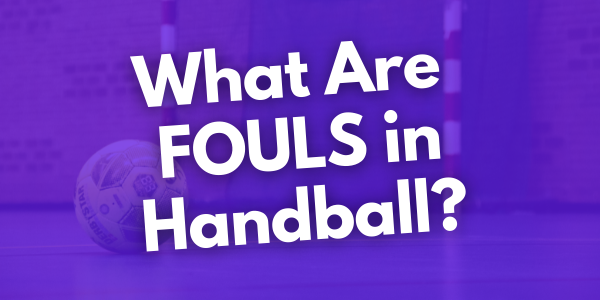When playing sports, it’s important to know what’s allowed and what isn’t. Here, I will describe what counts as a foul in handball so that you can avoid penalties, suspensions, and disqualification.
In a game of handball, any unnecessary physical behavior is considered a foul. Goalkeepers using their hands outside of their goal zone is also a foul. The referee will choose to punish the perpetrator with a warning, a 2-minute suspension, or dismissal from the game based on the severity of the foul.
Fouls such as pushing or a kick the ball in open play result in a spot free-throw. The game restarts from where the foul took place. If the foul was committed between the goal zone line and the 8-meter line, the foul results in a penalty shot.
Here is a list of unnecessary aggressive physical behavior considered a foul in handball to have a better understanding of which actions you need to avoid:
- Barging, Charging, or Tackling – Players can’t run directly into their opponents. An attacking player must attempt to side-step the defense to take a get open.
- Elbowing – You can’t use your elbows to push players away while making space for a pass or a shot.
- Swiping – While it’s perfectly legal to swing your arms to block ball movement on defense, you can’t swipe at players in an attempt to run past them while playing offense.
- Kicking the Ball – Handball players must not use any part of their leg below their knee to pass or shoot the ball. This results in a loss of possession. Goalkeepers are allowed to use their legs and feet to block shots inside their own goal zones.
- Snatching the Ball – Players are not allowed to rip the ball out of the opponent’s hands.
- Tripping – Any form of tripping is prohibited in handball. Players must not impede others’ movements.
- Pushing – Pushing is considered aggressive physical behavior and can result in a 2-minute suspension or a red card.
- Hitting – Punching, kicking, and any type of fighting results in automatic disqualification of the players involved.
- Clinching or Holding – Obstructing other players by holding onto their jersey, arms, legs, or hair is a foul. The degree of the infringement will dictate the punishment from a referee.
In general, the rules of handball are made to promote a non-violent sport. While the game is competitive and often physical, it’s important to avoid unnecessary physical aggression towards your opponents.
What Happens When a Player Commits a Foul in Handball?
A referee will use a whistle to stop a game of handball once a foul is committed and decide if the infringement is punishment-worthy. For common fouls, such as kicking the ball, the game will restart with a free throw. If a foul denies a clear goal-scoring opportunity, the referee can award a penalty shot.
Fouls always result in loss of possession. If a player commits a foul deemed severe by the referee, they can be shown a warning, given a 2-minute suspension, or be disqualified.
Are there Yellow and Red Cards in Handball?
Handball referees use 3 different cards to categorize fouls and infringements. Yellow, red, and blue. Any card can be shown to a player or a coach.
Yellow Cards
Yellow cards are a warning often awarded to players who have kicked the ball or inadvertently charged into an opponent.
- Players and coaches can only get one yellow card in a match.
- If a player or a coach with a yellow card commits a foul, they must serve a 2-minute suspension.
- A team can only get 3 yellow cards in one game.
Red Cards
Red cards are given to players for severe fouls such as tripping or unnecessary outbursts of violent physicality. A player or a coach receiving a red card is disqualified from the game.
- A referee can award a red card to a player or coach for any foul they deem to be outside of the rules of handball.
- Once a player gets a 3rd 2-minute suspension in one game, they are shown a red card and must leave the game. Their team must play a man down for 2 minutes before a different player takes their place.
- Goalkeepers are shows red cards using their hands outside of their goal zones to take away a goal-scoring opportunity. If the goalkeeper trips a player outside of the goal zone, they are also shown a red card.
Blue Cards
Players or coaches shown a blue card are disqualified and suspended for multiple subsequent games. Blue cards are mostly only awarded for fighting or verbally assaulting a referee. Blue cards are only common in professional leagues and the Olympic Games.
- A blue card can be shown to a player or coach after they’ve received a red card. If a referee deems a foul or infringement severe enough to warrant multiple suspensions, they can upgrade the perpetrator’s punishment.
Want to Know More About Handball?
If you want to learn all the rules of the game, I’ve put together an article with everything you need to know. It’s called Handball Rules, How to Play Handball. The guide is equipped with a bullet point list of all the rules you need to know to play the game. Regardless of if you play indoors or at a beach, the same rules apply.
There, you’ll find a downloadable PDF of all the rules and regulations. Feel free to download my guide and share it with your teammate and organization.
Keep playing this amazing game, and always remember to be competitive and have fun.
